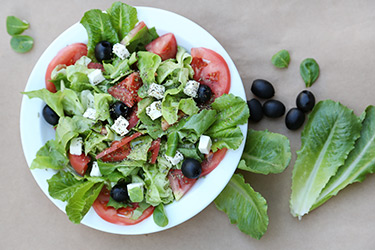.jpg)
Let’s chat diet today. More specifically I am going to chat about how to have flexibility in your diet to hit the goals that you want. But first, let me ask you a question? How many times have you set out on a diet only to fail because it is super restrictive in foods and calories? That’s NOT the type of “diet” I am going to be teaching today. I want you to imagine a life filled with all your favorite foods WITH some healthy options mixed in. This is called counting or tracking your macros. If you are more of a visual learner – I made a really informative YouTube video about this topic a few months back. Feel free to watch it here. If you want to calculate your macros from a worksheet, download my free macronutrient workbook here. If you are a blog lover (like myself) I’ll give you all the skinny details right now.
Let’s Figure Out Your BMR
To begin, grab a pencil and a piece of paper because we are going to do some math. In order to figure out how many “calories” you should be eating we first need to understand how much energy you are using every day. This is called your basal metabolic rate or BMR. Your BMR gives you a clue about how many calories your body needs to survive by doing nothing for 24 hours. It’s basically the minimum amount of calories needed to keep your body functioning. Foods main purpose, after all, is to help us SURVIVE! Yes, we have since become such a foodie world that it’s also a huge past time, but if you think of the real world role food has in our lives its purely for survival. In order to calculate your BMR we are going to use the Harris-Benedict Formula.
- Women: BMR = 655 + ( 4.35 x weight in pounds ) + ( 4.7 x height in inches ) – ( 4.7 x age in years )
- Men: BMR = 66 + ( 6.23 x weight in pounds ) + ( 12.7 x height in inches ) – ( 6.8 x age in years )
I’ll use my pre-pregnancy stats as an example.
BMR = 655 + (4.35 x 124) + (4.7 x 66) – (4.7 x 32)
BMR= 1,354.2
Let’s Figure Out The Calories You Need to Maintain Your Current Weight
Okay now that we have our BMR we need to figure out how many calories our bodies need everyday just to maintain our current weight. You’ll times your BMR by an activity factor that the Harris-Benedict Formula has provided:
-
- Sedentary (little or no exercise): BMR x 1.2
- Lightly active (light exercise/sports 1-3 days/week): BMR x 1.375
- Moderately active (moderate exercise/sports 3-5 days/week): BMR x 1.55
- Very active (hard exercise/sports 6-7 days a week): BMR x 1.725
- Extra active (very hard exercise/sports & physical job or 2x training): BMR x 1.9
As a note, I like to be more on the safe side here and not overestimate my activity output. I usually give myself a 1.4 – 1.55 depending upon my training schedule.
My example: 1,354.2 x 1.45 = 1,963.59 calories to maintain current weight.
Let’s Figure Out Your Goal
Are you trying to lose fat or gain muscle? You need to be very clear about your goal because that is going to determine the final amount of calories you will be striving to hit. Yes, you can lose fat AND gain muscle (this is pretty much the sweet spot). Scientifically speaking, 3,500 calories will equal one pound. Let me say that again – you are technically only supposed to gain one pound if you overeat by 3,500 calories per week. Now we know that is not always true (see section below), but for science sake, let’s go with that fact. In order to lose 1 pound a week, you need to eliminate 3,500 calories a week from your diet. 3,500 calories divided by 7 days a week is a calorie reduction of 500 calories a day. Pretty simple right? You can also factor in some calorie reduction from lifting and cardio but let’s just focus on 100% fat loss from diet right now since we used the Harris-Benedict Equation to factor in some activity levels already.
If you are trying to GAIN weight you can follow the same advice in reverse. You would add 500 calories a week to your diet to bulk or gain weight. You can also determine how much weight a week you want to gain (or lose). Say you want to aim for half a pound in either direction, then you would only need to minus or subtract 250 calories. Make sense? In order to both gain muscle/weight AND lose fat you’ll have to experiment for a bit. I find with my own body that I can do a small cut while increasing my lean muscle.
My Example: I want to build long lean muscle AND lose fat. I need 1,963.59 calories a day to maintain my current weight. I am going to do a small cut to maximize my calories for growth and energy. I’ll reduce calories by 150 a day to start.
Calories = 1,813.59/Day
Track Your Calories for a Week (IMPORTANT!!!)
So, chances are that you haven’t been eating the amount of calories the Harris-Benedict Formula indicates that you need. Maybe you are – but with my experience and most of the women I work with, you’re probably under eating. So, the BEST way to move forward is to figure out exactly how many calories you’ve been eating per day. Do this by downloading MyFitnessPal (a free app) and plugging in what you eat everyday. I don’t want to hear that it’s too difficult or time consuming. Listen, if you want to get detailed with your body you have to have some background information on yourself. Throw your big girl panties on and just make the commitment – you owe it to yourself and your longevity. After you figure out how many calories you’ve been consuming on a day-to-day basis you’ll have to decide what to do from there.
If you’ve been over eating – easy, go ahead with your HBE recommendation.
If you’ve been under eating – I’d recommend taking a few weeks to slowly add in calories so that you can restore and repair your metabolism to get your body to a great starting point. You in no way can lose weight or fat if you’ve been only consuming 1,200 calories for years on end. 1. It’s definitely not healthy for your body and 2. It’s definitely not healthy for your sanity.
The Role of Macros
I know this whole post so far has been about CALORIES but we are getting ready to switch gears to chat about MACROS now. We’re basically going to convert our calories into macros to hit our goals. Briefly – macros or macronutrients are the three basic components to every diet – fats, proteins, and carbs. Chances are you have never really paid attention to each macro and the role they play in your body ESPECIALLY when it comes to gaining muscle and losing fat. I honestly believe more time should be spent in school discussing macros and how beneficial it is to your body to NOURISH yourself with all three. The benefits and roles of each macro:
Fats – At LEAST 20% of your diet should come from fat consumption. Fats are used by your body for many reasons including insulation and energy reserve, healthy brain function, vitamin digestion, hormone balance and more.
Proteins – 15 – 35% of your diet should come from protein consumption. Protein is needed for building, maintaining, and repairing body tissue. There are many other uses for protein in the body but it also helps to aid the immune process (big factor if you’re always getting sick).
Carbohydrates – Yes EVERY person needs carbohydrates for many reasons but mainly to power the brain. The amount of carbohydrates needed by your body is going to vary greatly per person (we will get into this more below). The role of carbs in the diet vary from energy restoration and output, to powering our brains, hearts, and central nervous systems.
Obviously there is a lot more that goes into understanding the role and functions of macros in our bodies and I’m free to chat anytime about those benefits – but I’m going to keep it short in this blog post so that I don’t overload you with information today.
Let’s Calculate Your Macros
PROTEIN – Figure on allocating 1 gram of protein per goal body weight. You can go a little above and a little below – but this is a good frame of reference. There are 4 calories per gram of protein so you’ll multiply your grams of protein by 4 to figure out how many calories will be allocated toward this macro.
My Example: I am currently 124 pounds. Since I want to gain a little muscle I am going to shoot for 130 grams of protein a day. 130 grams x 4 calories = 520 calories. If I want to figure out the percentage of protein I’ll be consuming from my diet I will divide my protein calories (520) by my total calorie goal (1813.59) and divide it by 520 and see that 28% of my diet will be dedicated to protein.
FAT – Since we need a minimum of 20% of our diet coming from fats that gives us a good starting point. Now – if you are someone with a pretty normal body type with no real red flag hormonal or metabolic issues, I am going to recommend that your fat intake range from 20% – 30% of your total calories. If you are someone with a lot of belly fat or metabolic issues or if you’re diabetic I would recommend a HUGE chunk of your total calorie intake to come from fat since I would want you to limit your carbohydrate intake. For this blog post, I am going to assume that you are an everyday normal person. As an FYI, there are 9 calories per gram of fat. You’ll need to divide your total fat calories by 9 to convert your fat allowance into your fat macros.
My Example: I am going to strive for 30% of my total calories coming from fat consumption. I’ll take my calorie goal of 1813.59 x .30 = 544.077 calories dedicated to fat. To get that into macros you’ll divide the calories by 9 (since there are 9 calories per gram of fat). So, 544.077/9 = 60.45 grams of fat per day.
Recap: Protein will make up 28% of my total caloric intake (520 calories) or 130 grams of protein. Fat will make up 30% of my caloric intake (544 calories) or 60.45 grams of fat.
CARBOHYDRATES – To figure out your carbohydrate consumption, add together your calories from your protein and fat and then minus your caloric goal from that total. You’ll then divide that number by 4 (there are 4 calories per gram of carbohydrate) to figure out your carb macro per day.
My Example: 520 protein calories + 544 fat calories = 1064 total calories. I’ll take my daily caloric goal of 1813.59 and minus 1064 calories to get = 749.5 carbohydrate calories. 749.5 calories/ 4 = 187.39 grams of carbohydrates per day. To figure out the % I can take 749.5 calories / 1813.59 = 41 % of my daily calories will come from carbs.
Recap (specific to me):
Protein = 130 grams/day or 28% of total calories
Fat = 544 grams/day or 30% of total calories
Carbohydrates = 749 grams/ day or 41% of total calories
Now that you have figured out how to calculate your macros specifically for YOUR body and YOUR goal – you will need some sort of app to track your macros. I prefer MyFitnessPal. It is free and easy to use and comes with all sorts of data. It’s also available on your desktop or smartphone. You can also upgrade your account so that you can input your EXACT grams per macronutrient. If you use the free version, you’ll have to track using percentages only. Please refer to my YouTube video about how to input your macros into MyFitnessPal.
Final Thought
I recently had someone message me asking about alternative diets because she felt super trapped by making the same food choices while tracking her macros. Let me be CLEAR! One of the most beautiful parts of tracking your macros is the versatility you can achieve with your food! If you think that you are limited to only eating chicken, asparagus, and rice then you are sorely mistaken. I have such a variety of food in my diet including pizza, ice cream, spaghetti, and bread. On the other hand, I also eat PLENTY of fruits, veggies, lean meats, whole grains, and healthy fats. Tracking your macros should be a balance in life. It should give you a better understanding of your diet and how following certain macros can truly change your body figure and overall health. I want you to think of each macronutrient as a piggy bank. As soon as you have eaten your scheduled grams of carbs, proteins, or fats – move on to the next macro piggy bank. If you want ice cream – EAT IT! Track it. Move on. If you want pizza, EAT IT! Track it. Move on. If you are tracking correctly, you will see that it is impossible to fill your day with junk. You will quickly use up your fat and carbohydrate piggy banks and will only have protein left. Try to eat a variety through the day, pulling from all three categories evenly through the day so that you have well balanced meals.
If you need help setting up your macros, finding a workout program to hit your goals, or need some nutrition coaching I offer all three of those services! It is a huge passion of mine to help women become strong and healthy versions of theirselves without feeling deprived. Please check out my services here. That’s it for now! Please drop me a comment below with any questions that you have.
.png)













.jpg)
.jpg)















